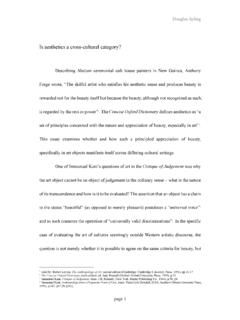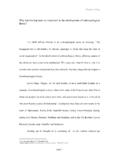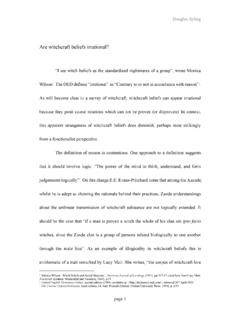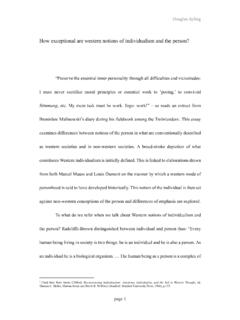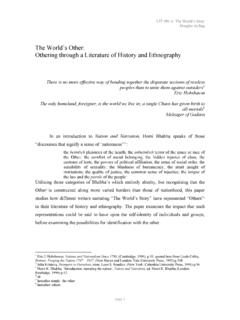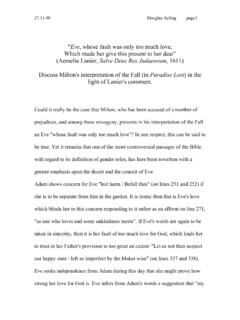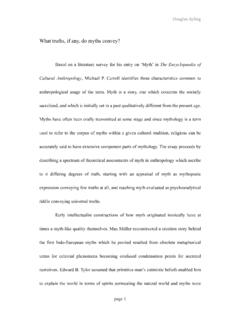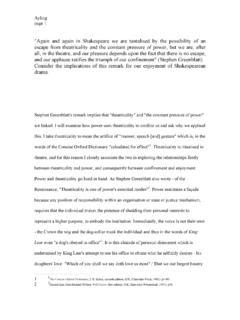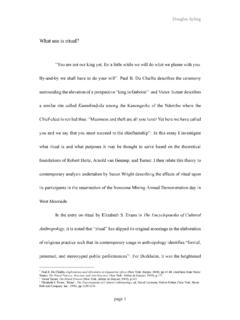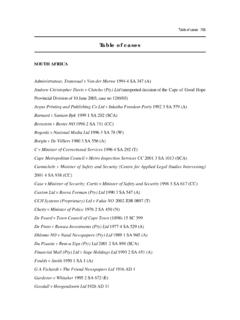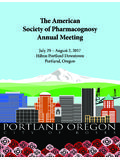Transcription of Men Performing Women, Constructions of Gender …
1 MSc in Social Anthropology Dissertation Men Performing women : Constructions of Gender in contemporary japanese comedy douglas Ayling Candidate number: 29350 douglas Ayling page 2 Men Performing women : Constructions of Gender in contemporary japanese comedy Contents 1. Introduction and research 3 Situating the research questions within the cultural 3 2. Existing 5 Sex and Gender in 5 Sex and .. 5 japanese cultural Constructions of masculinity and 7 Transgender in 10 Performance and 11 Performing 11 Humour using Gender 13 Cross- Gender performances in 19 japanese 21 Manzai in 23 24 3. Three theories of 25 4. 28 5. Visual texts: Exposition and 30 konyakusha ha gaikokujin , Darling 30 touji no omokage , 31 waratte ha ikenai onsenyado , 34 kono yo de ichiban tsuraikoto , 36 6.
2 38 Constructions of 38 Cultural specificity and theories of 39 How radical, how conservative? .. 41 Notes on 44 Appendix 1: Copy of questions in Manzai 45 Appendix 2: Table of responses to question 46 Appendix 3: Terminology sex , Gender , sexuality ; the west ; manzai .. 48 51 Internet 54 Visual 55 douglas Ayling page 3 1. Introduction and research questions This dissertation examines a selection of instances in contemporary japanese comedy in which men act as women and asks what Gender constructs men use when they are impersonating women in Japan. The study then asks why this is funny locally and to what extent these manifestations of humour do or do not fit into more universal theories of humour. Together with existing literature, these theories enable us to compare theoretical propositions regarding the impact of this kind of humour on Constructions of Gender and prompt us to ask how radical or conservative these acts are.
3 Situating the research questions within the cultural context As with any symbolic system japanese culture displays distinctive modes of differentiating between male and female Gender roles. For a developed nation with the third largest1 economy in the world however, and as a member of OECD that shares many of the characteristics of other liberal, westernised, democratic and capitalist member states, Japan s average wage for women is relatively low compared to that of men2 and reflects what the literature generally reports as a low status for women compared to men. Although there is a frequent tendency towards essentialism within 1 On PPP (Purchasing Power Parity).
4 CIA, The World Factbook 2005, available at: < >, retrieved: 1st September 2005 2 Fig Monthly Contractual Earnings by Size of Enterprise (2003), Statistics Bureau & Statistical Research and Training Institute, Ministry of Internal Affairs and Communications, source: Ministry of Health, Labour and Welfare, < #cha12_4>, retrieved 1st September 2005 douglas Ayling page 4 Nihonjinron (literature about the japanese ), the japanese language may be considered as an ongoing means by which Gender differences are circumscribed and perpetuated since in it the male and female voices are normatively ascribed different personal pronouns, verb endings and registers. In this context the question of whether locally humorous representations of Gender within contemporary japanese comedy are culturally specific is thought to be of particular interest.
5 If, for example, they can be appreciated locally but not more universally one might be better placed to make assertions regarding both the local Constructions of Gender and the relationship between the operation of humour in general, and local Constructions . If, on the other hand, one observes these humorous representations of Gender to be both appreciable from outside japanese Gender constructs and consistent with predominantly western theories of humour, one would want to know how to characterise these Gender jokes within a broader typology of humour and then ask in what way this type of joke affects the Gender construct it refers to. douglas Ayling page 5 2. Existing literature A considerable body of literature exists on the area of humour in general, significantly less on humour arising out of cross- Gender performances.
6 Similarly, there is a sizable body of work on the role and status of women in japanese society and a growing corpus on masculinity however, there is relatively little on men Performing as women . This literature review chapter approaches the topic specific to this dissertation from three intersecting axes: Gender , performance and humour. I first examine the literature on Gender in Japan, then I examine writing on performance both in Japan and globally as it relates to Gender . Subsequently humour in Japan is contextualised. Sex and Gender in Japan Sex and status In the workplace, while Japan has a relatively high percentage of women in the workforce at , patterns of employment differ significantly for women in Japan as against other industrialised countries.
7 From 1992 statistics, women s average wage was 50% that of men s in Japan compared to 74% for the equivalent disparity in the US4. With length of employment this gap in pay increases and women tend to leave for longer periods to have children than in western economies, subsequently 3 2003 figure; Anthony Faiola, japanese women Live, and Like It, On Their Own: Gender Roles Shift As Many Stay Single , , available at: < >, posted: 31st August 2004, retrieved: 1st September 2005 4 Gordon Mathews, Can a real man live for his family?: ikigai and masculinity in today s Japan , Men and Masculinities in contemporary Japan: Beyond the Urban Salaryman Model (London: Nissan Institute/Routledge japanese Studies, 2003), douglas Ayling page 6 finding it difficult to return to work on the same pay or status.
8 The range of occupations which japanese women tend to occupy is narrow with very few women in upper management positions. Furthermore, the pattern of employment discourages investment in training for women . Alice H. Cook and Hayashi Hiroko5 go so far as to remark in 1988 that combined with wider ideology about women s roles, women are probably more exploited in Japan than in any other industrialised society. The stereotype of the OL or Office Lady who has few opportunities for promotion and makes tea for her male colleagues is far from obsolete. In language use, the pejorative associations embedded in Sino- japanese ideographs have been examined by Kawata (2000)6; and Ogino (1992), Fukada (1993) and Yamaguchi (1998) have commented on the use of the word shujin (literally master ) for husband.
9 The kotoba to onna o kangaeru kai ( Group for Thinking about Language and women )7 found in 1985 upon conducting an analysis of the definitions and examples used in japanese dictionaries that women were invariably represented as passive, nice and pretty and referred to in terms of appearance or promiscuity, whereas men were represented as the strong, reliable agents of actions and referred to in the contexts of taking the initiative and influencing women s lives. Publishers have addressed some of these criticisms. Similarly, in 1993 a survey of newspaper language undertaken by Kazuko Tanaka8 critiqued the double standard applied to men and women as reflecting a patriarchal viewpoint.
10 Tanaka drew attention to the unnecessary marking of women ( the female company president ), the female subject placed within relational frames ( Yoko, the wife of .. ) and the 5 Alice H. Cook and Hayashi Hiroko, Working women in Japan , Inside the japanese System: Readings on contemporary Society and Political Economy (Stanford: Stanford University Press, 1988) 6 Cited by Sumiyuki Yukawa, and Masami Saito, japanese Language, Gender , and Ideology: Cultural Models and Real People, ed. Shigeko Okamoto and Janet S. Shibamoto Smith (Oxford: Oxford University Press, 2004), 7 Yukawa and Saito (2004), 8 Cited by Yukawa and Saito (2004), douglas Ayling page 7 extensive use of stereotypical images of women as emotional, considerate, devoted and passive.
